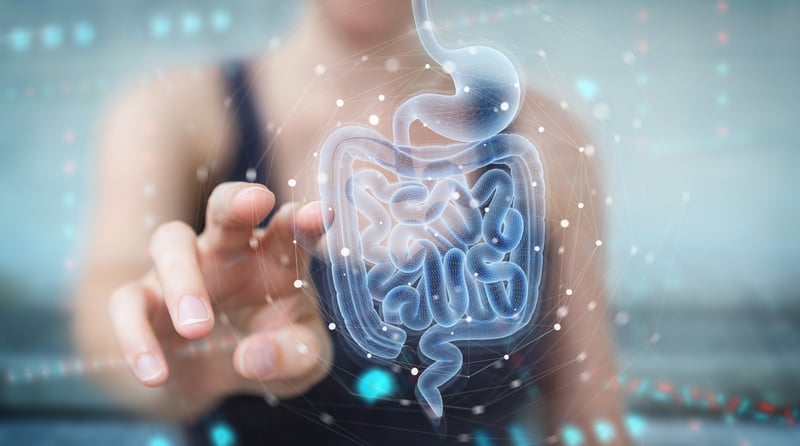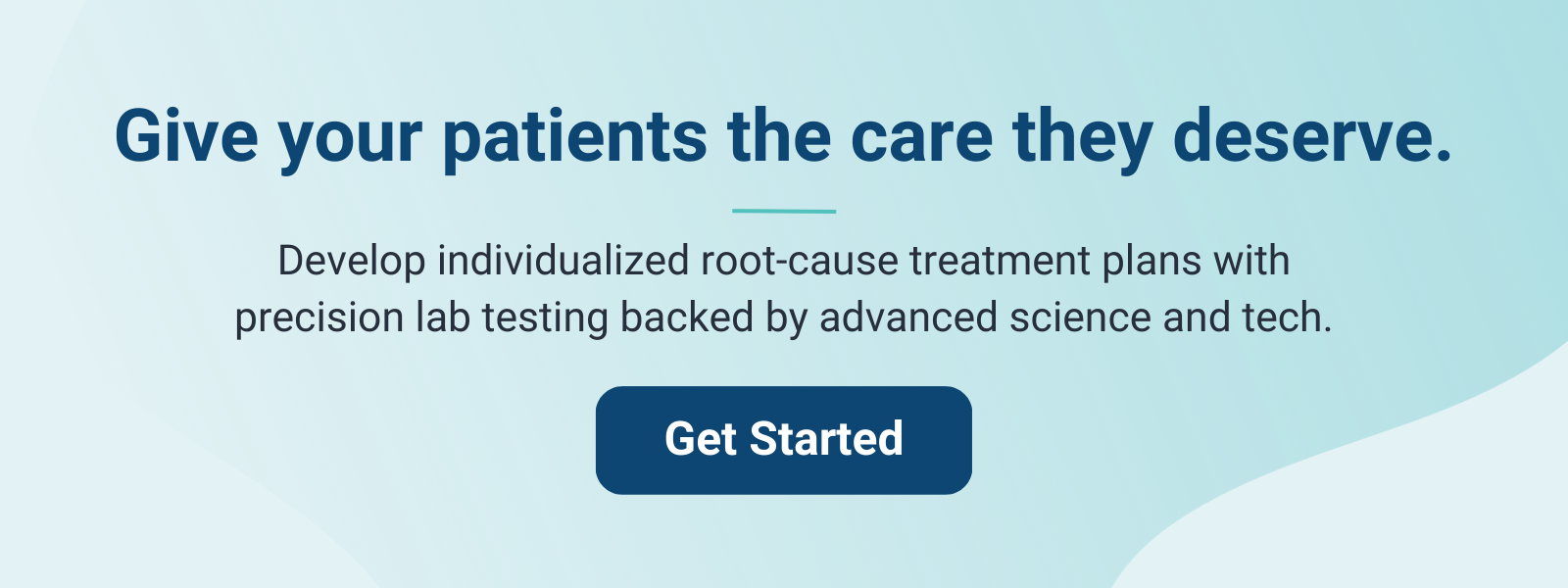Balancing Estrogen: Why the Gut Microbiome Matters
Functional medicine is constantly evolving, with increasing research revealing the intricate links within our bodies. Recently, focus has been on the link between the gut microbiome, estrobolome, and their impact on estrogen metabolism.
Estrogen imbalance can have a range of clinical implications, ranging from cognition to metabolic syndrome to cardiovascular disease.
In this blog, we explore the link between the gut microbiome, estrobolome, and estrogen metabolism. We'll cover how these systems impact health, highlight diagnostic tools, and discuss practical strategies to enhance patient care. It's a roadmap for effectively addressing gut health and hormone balance in your practice.
Zooming into the Gut Microbiome

Our gut microbiome is a diverse collection of microorganisms living within our digestive tract. This ecosystem is far from idle—it impacts every part of our health.
The microbiome plays a pivotal role in a range of health facets, from nutrient metabolism and immune regulation to detoxification and the gut lining. They not only aid in digesting food but also assist in absorbing essential vitamins and defending against harmful pathogens.
Yet, when the microbiome becomes unbalanced—a condition called gut dysbiosis—it can contribute to health problems. These might include:
- Gastrointestinal issues like irritable bowel syndrome
- Autoimmune diseases like rheumatoid arthritis
- And even skin conditions such as eczema
Given that 70 to 80% of our immune system is in the gut, maintaining a balanced gut microbiome is vital for health and longevity.
The Estrobolome and Estrogen Metabolism

The estrobolome is part of the gut microbiome, but it serves a specific function—it contains microbial genes that metabolize estrogens. These hormones are crucial for reproductive health, and they also regulate bone density, metabolism, brain function, and mood.
The estrobolome secretes the enzyme β-glucuronidase, which kicks off the estrogen-recycling process. In this process, estrogens are conjugated in the liver, excreted into the gut, and then deconjugated by the estrobolome. This last step allows estrogens to reabsorb into the body, affecting hormonal balance.
But when changes in the microbial composition disrupt the estrobolome, it can lead to irregular estrogen metabolism. These disruptions can cause an estrogen imbalance, contributing to several serious conditions, including:
- Endometriosis
- Cancer
- Obesity/metabolic syndrome
- Polycystic Ovary Syndrome (PCOS)
- Endometrial Hyperplasia (EH)
- Cardiovascular Disease
- Infertility
- And decreased brain function
The Symbiotic Relationship of Gut Microbiome and Estrogen Metabolism
The connection between the gut microbiome and estrogen metabolism is a mutually beneficial relationship. The gut microbiome is influenced by estrogen. Similarly, the gut microbiome has a significant influence on estrogen levels.
A balanced gut microbiome helps maintain a healthy estrobolome, and supports optimal estrogen metabolism.
However, changes in the gut microbiome can impact the estrobolome (and vice versa). Several factors, including diet changes, stress, antibiotic use, and exposure to environmental toxins, can trigger dysbiosis, altering the estrobolome and estrogen metabolism.
Assessing the Microbiome and Estrogen Metabolism

Understanding these complex interactions is no simple task. This is where precision diagnostic tools like the Vibrant Gut Zoomer and Salivary Hormone testing come in.
The Vibrant Gut Zoomer examines the diverse microorganisms and metabolites in the gut, along with digestive health and inflammation markers. This detailed analysis provides a full view of the gut microbiome, helping you pinpoint potential causes of illnesses linked to gut microbiome dysbiosis. Further, it helps you understand how changes in the gut microbiome could influence the functioning of the estrobolome and disrupt estrogen metabolism.
Pair the Gut Zoomer with the Vibrant Salivary Hormones Panel for crucial insights into a patient's hormone levels. It measures reproductive and metabolic hormones for a detailed view of the hormone pathways and their metabolites. This comprehensive assessment can identify hormonal imbalances, which could result from changes in the estrobolome and the gut microbiome. It helps understand the sequence of events, from environmental, nutritional, or genetic factors to symptoms related to estrogen imbalance.
Together, the Vibrant Gut Zoomer and Vibrant Hormones Panel reveal a holistic picture of a patient's gut and hormone health. Viewing these health domains side-by-side better equips you to identify, manage, and treat conditions related to the gut microbiome, the estrobolome, and estrogen metabolism.
Improving the Gut Microbiome and Estrogen Metabolism

Once you’ve assessed your patient’s gut health and hormonal balance, there are several practical ways to improve it:
Dietary Changes
Numerous studies have shown that diet plays a major role in shaping the microbiome. Promote a fiber-rich, diverse diet with whole grains, fruits, vegetables, legumes, and fermented foods. Reduce processed foods, sugars, and saturated fats.
Regular Exercise
Studies have found that exercise can increase total beneficial microbial, enhance microflora diversity, and help develop commensal bacteria.
Mindful Antibiotic Use
Research suggests that antibiotics can significantly disrupt the gut microbiota, reducing its diversity and altering its composition for months or even years. Therefore, use antibiotics thoughtfully. Consider probiotic supplements before and after antibiotic treatments.
Reduce Toxic Burden
Exposure to certain chemicals like arsenic or pesticides is linked to gut microbiome dysfunction. Consider running toxic burden diagnostics like the Vibrant Total Tox Burden to measure your patient’s toxic load and identify potential sources of chronic exposure.
Regular Check-ups
Routine follow-up visits and diagnostics can help to monitor progress and enable early interventions. Studies show that the microbiota in daily samples can vary up to 10 times from one sample to another. Over a longer period, like six weeks, this difference can be even more drastic—up to 100 times.
Note, that the above list of interventions isn't exhaustive. There are many ways to improve gut health and estrogen metabolism based on individual patient needs.
Understanding the complex interplay between the gut microbiome, the estrobolome, and estrogen metabolism is crucial for comprehensive patient care. These interconnected systems significantly contribute to our overall health, affecting everything from menopausal symptoms to metabolic changes.
Any imbalance can lead to serious health issues, including hormone-sensitive cancers. Tools like the Vibrant Gut Zoomer and Salivary Hormones Panel can be instrumental in identifying these imbalances and helping you create personalized, effective treatment plans.
Regulatory Statement:
The general wellness test intended uses relate to sustaining or offering general improvement to functions associated with a general state of health while making reference to diseases or conditions. This test has been laboratory developed and its performance characteristics determined by Vibrant America LLC and Vibrant Genomics, a CLIA-certified and CAP-accredited laboratory performing the test. The lab tests referenced have not been cleared or approved by the U.S. Food and Drug Administration (FDA). Although FDA does not currently clear or approve laboratory-developed tests in the U.S., certification of the laboratory is required under CLIA to ensure the quality and validity of the tests.
 By
By



